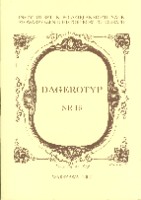Wilnianin Johann Hiksa – fotograf Starego Kontynentu
Johann Hiksa of Vilnius – photographer of the Old Continent
Author(s): Margarita MatulytėSubject(s): Photography
Published by: Instytut Sztuki Polskiej Akademii Nauk
Keywords: photography; Polish photography; vintage photography; old photographic technique; Hiksa; Johann; Vilna; Werki; Sayn-Wittgenstein; everyday life; aristocracy
Summary/Abstract: W.J. Hiksa (1859-1934; ill. 5, 13), one of the most distinguished amateur photographers in Lithuania in the nineteenth century, was an administrative worker in Werki, the estate of the prince Peter Sayn-Wittgenstein, and subsequently Maria née Wittgenstein and Chlodwig Hohenlohe-Schillingsfürst. His level of educational attainment is unknown, nor are his initial professional duties. During the time of Peter Sayn-Wittgenstein his activities included accompanying the prince on his many travels and taking photographs. He arranged a photographic laboratory in the grounds of the estate, in the home of the park warden (ill. 7-8). The photographic portraits made there he sometimes signed with the stamp Atelier de Werki|J.Hiksa. Hiksa started taking photographs at the age of seventeen, perhaps earlier. His oldest, best-known photographs come from 1876 and were taken in France (ill. 11). The main theme of Hiksa’s work is the everyday life of the aristocracy, in particular his employers, the Sayn-Wittgensteins (ill. 6), their relatives, servants (ill. 8), views of Werki and the surrounding area as well as views of places visited during foreign travels. He left three photo albums (484 photographs in total, the Lithuanian National Museum in Vilnius), many photographs in the collections of the Sayn-Wittgenstein and Hohenlohe-Schilingsfürst families, as well as in the collection of Gerhard Seinbold, in Germany (published in his Die Radziwille Masse..., Gerabronn und Crailsheim 1988, however, without revealing the author), as well as the diary „Reisen des Johann Hiksa in den Jahren 1868 [...] 1906” (manuscript, Lithuanian National Museum). The period of intensive photographing by Hiksa (up to 1887, the death of Peter Sayn-Wittgenstein) coincides with the beginning of impressionism in art. On the basis of entries into his diary, one can presume that he saw the fifth (1880), seventh (1882) and eighth (1886) exhibition of the impressionists, as he was in Paris at the time. The influence of the paintings Hiksa saw is noticeable in photographs such as „Girl in the sun” (ill. 12; see C. Monet, „The Artist’s Garden at Argenteuil”, 1873), as well as the series „In the Werki park” (ill. 10; see E. Manet, „The Monet Family in their Garden”, 1874.) Hiksa’s photographs are characterised by a large degree of individualism, unconventional composition, creative and bold approach. Hiksa’s oeuvre is not fully discovered, documented and researched. He remains a little-known photographer, despite three exhibitions (Vilnius – 2001, Gdańsk – 2003) and publications by the author of this article, M. Matulytė, Photography of Vilnius, 1858-1915, Vilnius 2001, pp. 39-41, 462-463.
Journal: Dagerotyp
- Issue Year: 2004
- Issue No: 13
- Page Range: 15-22
- Page Count: 8
- Language: Polish
- Content File-PDF

